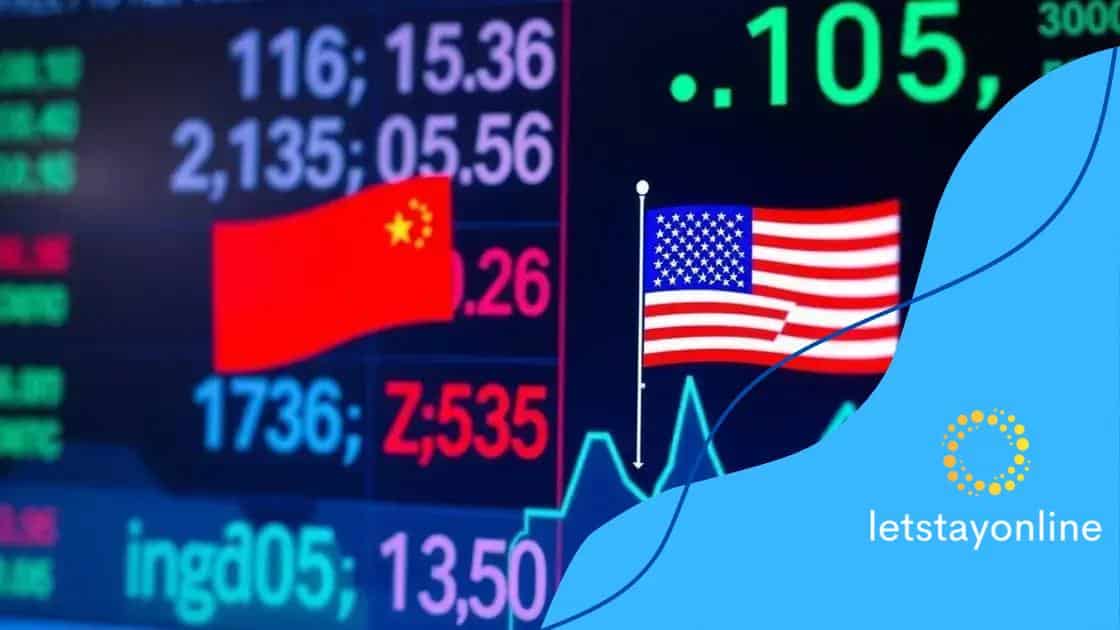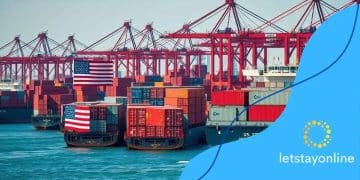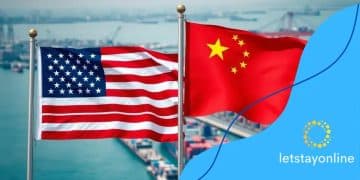US-China trade tensions affect markets and opportunities

US-China trade tensions significantly impact global markets, affecting key sectors like technology, agriculture, and automotive, while requiring investors to adapt their strategies to navigate the resulting volatility and uncertainty in economic relations.
US-China trade tensions affect markets in complex ways, influencing everything from stock prices to consumer behavior. Curious about how these shifts could impact your investments? Let’s dive into the details.
Understanding US-China trade dynamics
Understanding the US-China trade dynamics is essential for grasping the larger economic picture. With both countries being major players in global markets, their trade relationships can have far-reaching effects. Let’s explore some key factors that influence these dynamics.
Key Elements of Trade Relationships
There are several components that shape the US-China trade relationship:
- Tariffs: Tariffs can increase the cost of imported goods, affecting both consumers and businesses.
- Quota systems: Quotas limit the number of goods that can be imported or exported, impacting availability.
- Trade agreements: Agreements can facilitate better trade terms and reduce trade barriers, benefiting both nations.
- Currency manipulation: Adjusting currency values can make exports cheaper or more expensive, influencing trade balances.
As these elements interplay, the US-China trade dynamics create both opportunities and challenges. Businesses must stay informed to navigate these complexities effectively.
Recent Developments
Recent developments have seen shifts in policy from both sides. For instance, the US has imposed tariffs on certain Chinese products, aiming to protect domestic industries. In response, China has also adjusted its tariffs, leading to a back-and-forth that complicates the trade landscape.
This continuous adjustment creates a fluctuating environment for imports and exports. Understanding these changes is crucial for businesses contemplating expansion or investment in these markets.
Furthermore, the impact of US-China trade tensions extends beyond tariffs. For example, companies may need to rethink their supply chains. This could mean sourcing materials from different countries to reduce dependency on either nation. The interconnectedness of the global economy makes these decisions critical.
In summary, understanding the US-China trade dynamics requires ongoing observation of how these various components interact. Stakeholders need to remain agile, adapting to changes swiftly to maintain competitive advantages.
Impact on global markets

The impact on global markets from the ongoing trade tensions between the US and China is profound. Investors need to understand how these dynamics affect financial markets worldwide. With a volatile relationship, stock prices and investments can fluctuate unexpectedly.
Effects on Stock Markets
When trade tensions rise, investor confidence often dips. This can lead to:
- Increased volatility: Stocks may experience sharp price changes.
- Sector-specific impacts: Industries like technology and manufacturing can be hit hardest.
- Panic selling: Investors may rush to sell their holdings to avoid losses.
- Long-term investments: Strategic investors might hold firm, betting that tensions will eventually ease.
As stocks shift, global markets react to each headline. These reactions can lead to a domino effect, impacting other economies linked to the US and China.
Currency Fluctuations
Another area to consider is currency exchange rates. The US-China trade tensions can lead to fluctuations in currencies, especially the US dollar and Chinese yuan. A strong dollar can make US exports more expensive, affecting the trade balance. Meanwhile, a weaker yuan can boost Chinese exports, intensifying competition.
Understanding these fluctuations is critical for international businesses, as they can influence pricing strategies. Business leaders must stay alert to currency changes, as they impact profitability and competitive positioning.
The impact on global markets is not limited to stocks and currencies. Commodity prices, such as oil and metals, often respond to trade news as well. For example, increased tensions can lower demand for commodities if economic activity slows down.
Ultimately, the interconnected nature of today’s markets means that the US-China trade tensions reverberate far beyond their borders. Other nations feel the effects as they adjust their trade strategies and policies in response. A keen awareness of these factors helps investors make informed decisions.
Key sectors affected by trade tensions
Several key sectors are critically influenced by the ongoing trade tensions between the US and China. Understanding these sectors can help businesses make informed decisions during uncertain times. Let’s examine the sectors that often feel the most impact from these trade dynamics.
Technology Sector
The technology sector is one of the most affected by trade tensions. Companies that rely on the global supply chain for electronics face significant challenges. Key points include:
- Tariffs on components: Increased costs for parts can raise the price of consumer electronics.
- Restriction on components: Limitations on technology exports can hinder production.
- Market uncertainties: Companies may delay investments due to unclear future regulations.
These factors make it crucial for tech companies to remain agile and adapt their strategies as needed.
Agriculture Sector
The agriculture sector also sees considerable impacts from trade tensions. Farmers often rely on exports to China, which can fluctuate based on trade policies:
- Export tariffs: Tariffs on American agricultural products can cut into profit margins.
- Subsidies and support: Government support may change, affecting farmers’ operations.
- Market shifts: Farmers may need to find new markets or adjust crop production accordingly.
Understanding these changes is key for agricultural stakeholders to navigate challenges effectively.
Furthermore, the automotive industry is not spared from the effects of trade tensions. The automobile market intersects heavily with trade policies. When tensions rise, the industry sees:
- Increased costs: Tariffs can raise prices on imported vehicles and parts.
- Supply chain disruptions: Difficulty sourcing materials can delay production.
- Market competitiveness: Fluctuating prices may affect consumer buying behaviors.
Finally, the energy sector plays a vital role. Trade tensions can lead to:
- Changes in demand: Tariffs may influence the demand for oil and gas in different markets.
- Investment shifts: Investors may change their focus based on trade relationships.
- Price volatility: Energy prices can fluctuate rapidly in response to news and policies.
In summary, key sectors like technology, agriculture, automotive, and energy are significantly affected by trade tensions. Businesses in these industries should closely monitor these dynamics to adapt effectively.
Investment strategies during trade conflicts

Investment strategies during trade conflicts require careful planning and agility. With trade tensions affecting market dynamics, investors must adapt their approaches to protect their portfolios and capitalize on potential opportunities. Here are some effective strategies to consider when navigating these uncertain waters.
Diversification of Investments
Diversification is key in uncertain times. By spreading investments across different sectors and geographies, you can minimize risks associated with trade conflicts. Consider:
- Global exposure: Invest in international markets that might not be directly affected by US-China tensions.
- Sector rotation: Shift focus towards sectors that typically perform well during market downturns, such as utilities or consumer staples.
- Alternative investments: Explore options like real estate, commodities, or precious metals.
These strategies can help cushion your portfolio against volatility.
Focusing on Stable Stocks
Another approach is to invest in well-established companies, also known as blue-chip stocks. These companies often have strong fundamentals and consistent performance regardless of market conditions. Look for:
- Strong balance sheets: Companies with low debt and high cash reserves can weather economic storms more effectively.
- Diversified revenue streams: Businesses that have multiple sources of income may be less vulnerable to trade conflicts.
- Consistent dividends: Stocks that regularly pay dividends can provide income during market fluctuations.
Staying focused on these stable investments can lower your risk during periods of uncertainty.
As trade tensions evolve, staying informed about policy changes and their implications is crucial. Utilize market research and financial news to gauge the sentiment of investors and adjust your strategies accordingly. This proactive approach can help you spot emerging trends and optimize your investment decisions.
Additionally, consider employing options trading as a strategy during trade conflicts. Options can provide leveraged opportunities or protect your investments. Strategies such as buying puts can hedge against potential losses in a bearish market, while calls can allow you to capitalize on rising stocks.
In conclusion, successful investment strategies during trade conflicts involve diversification, focusing on stable companies, and remaining adaptable to changing market dynamics. Understanding these strategies can better position investors to navigate the uncertain landscape caused by US-China trade tensions.
Future outlook of US-China relations
The future outlook of US-China relations is uncertain and complex. As global powers, their interactions significantly influence world markets and international policies. Predicting how these relations will evolve requires understanding various factors at play.
Political Landscape
The political environment in both countries heavily impacts their relationship. With ongoing political changes, both nations’ leaders may adopt different stances on trade and cooperation:
- Diplomatic negotiations: High-level talks may lead to agreements or further tensions.
- Domestic policies: National interests can drive a country’s stance, affecting trade policies.
- Public sentiment: How citizens view each other can influence governmental decisions.
Monitoring these factors is crucial for stakeholders looking to navigate future market scenarios.
Economic Factors
Economically, the future of US-China relations will be shaped by trade balances and economic policies. Both nations are likely to reassess their strategies:
- Supply chain diversification: Companies may look to spread their supply chains beyond just these two countries.
- Investment flows: Changes in investment patterns can signal shifting relations.
- Tariff adjustments: Future tariff policies may either ease or escalate trade conflicts.
Understanding these economic shifts helps businesses adapt their strategies effectively.
Another key element is technology. The race for technological supremacy is a significant driver in US-China relations. With advancements in areas like AI and cybersecurity, competition is fierce:
- Intellectual property rights: Disputes over IP are likely to remain a contentious issue.
- Research collaborations: Future partnerships in technology can be a double-edged sword.
- Regulatory policies: Future regulations will shape how tech companies operate internationally.
While examination of these variables provides insights, the reality remains fluid, and unexpected developments can shift the landscape rapidly.
In summary, the future of US-China relations hinges on political, economic, and technological factors. Stakeholders must stay informed and agile to navigate this evolving relationship.
In conclusion, understanding the US-China trade tensions is crucial for anyone involved in global markets. The dynamics between these two countries can significantly influence various sectors and investment strategies. Staying informed about political, economic, and technological changes can help businesses and investors adapt effectively. With careful planning and agility, one can navigate this complex landscape. Always remember that the future is unpredictable, and being flexible is key to success.
FAQ – Questions about US-China Trade Tensions and Their Impact
What are US-China trade tensions?
US-China trade tensions refer to the ongoing economic conflicts between the two countries, primarily involving tariffs and trade policies that can affect global markets.
Which sectors are most affected by these trade tensions?
Key sectors include technology, agriculture, automotive, and energy, all of which can experience price fluctuations and shifts in demand due to tariffs and policies.
What investment strategies can help during trade conflicts?
Diversification, focusing on stable stocks, and staying informed about market changes are essential strategies to navigate investment risks during trade tensions.
How might the future of US-China relations affect global markets?
The future dynamics between the US and China could lead to increased market volatility, influencing trade balances and investment flows internationally.






